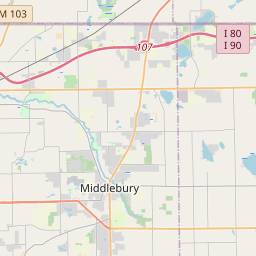Chief Shipshewana Memorial
Historical marker location:
Shipshewana, Indiana
( Marker is at the intersection of County Road N900W and County Road N905W, on the left when traveling north on County Road N900W.)
Marker installed: 2003







© OpenStreetMap contributors
Loading...
Searching for other points of interest within 3 miles of this location.The first European settlement in Indiana was established by the French in 1732 at Vincennes, in the southwestern part of the state.
About Lagrange County
Lagrange County Timeline
Lagrange County, Indiana, named after the famous French mathematician Joseph-Louis Lagrange, has a rich history that dates back to the early 19th century. The area was originally inhabited by various Native American tribes, including the Miami and Potawatomi. European settlers began arriving in the early 1830s, attracted by the fertile land and abundant natural resources.
The county was officially established in 1832 and quickly grew as more settlers arrived to claim land and establish communities. Lagrange County was an important center for agriculture, with farmers cultivating crops such as corn, wheat, and soybeans. The development of railroads in the late 19th century further supported the county's growth, facilitating transportation and trade.
The late 19th century saw the rise of several industries in Lagrange County, including manufacturing, sawmills, and brickmaking. The town of Lagrange became the county seat and a hub of economic activity. However, like many other rural areas, Lagrange County faced challenges during the Great Depression and the decline of agriculture in the mid-20th century. Many residents left in search of better opportunities in urban areas.
In recent years, Lagrange County has experienced a resurgence in tourism and outdoor recreational activities due to its beautiful landscape and extensive recreational areas. The county is home to numerous lakes, parks, and campgrounds, attracting visitors from far and wide. Lagrange County remains a close-knit community that celebrates its agricultural roots while embracing economic diversification.
The county was officially established in 1832 and quickly grew as more settlers arrived to claim land and establish communities. Lagrange County was an important center for agriculture, with farmers cultivating crops such as corn, wheat, and soybeans. The development of railroads in the late 19th century further supported the county's growth, facilitating transportation and trade.
The late 19th century saw the rise of several industries in Lagrange County, including manufacturing, sawmills, and brickmaking. The town of Lagrange became the county seat and a hub of economic activity. However, like many other rural areas, Lagrange County faced challenges during the Great Depression and the decline of agriculture in the mid-20th century. Many residents left in search of better opportunities in urban areas.
In recent years, Lagrange County has experienced a resurgence in tourism and outdoor recreational activities due to its beautiful landscape and extensive recreational areas. The county is home to numerous lakes, parks, and campgrounds, attracting visitors from far and wide. Lagrange County remains a close-knit community that celebrates its agricultural roots while embracing economic diversification.
Lagrange County Timeline
This timeline provides a condensed summary of the historical journey of Lagrange County, Indiana.
- 1832: Lagrange County is established in the state of Indiana.
- 1837: The county courthouse is built in the town of Lima, which later becomes known as LaGrange.
- 1842: LaGrange County's first newspaper, the "LaGrange Standard," is published.
- 1860: The population of LaGrange County reaches over 10,000 people.
- 1877: The Grand Army of the Republic (G.A.R.) Hall is constructed in the town of LaGrange.
- 1895: The county's first telephone system is established.
- 1908: LaGrange County's first automobile, a Ford Model T, is purchased.
- 1925: The Strawberry Festival is held for the first time in Shipshewana, becoming an annual tradition.
- 1956: The LaGrange County Historical Society is founded.
- 1995: The Topeka Historic Depot Museum opens, showcasing the county's railroad history.
- 2007: The population of LaGrange County exceeds 37,000 people.